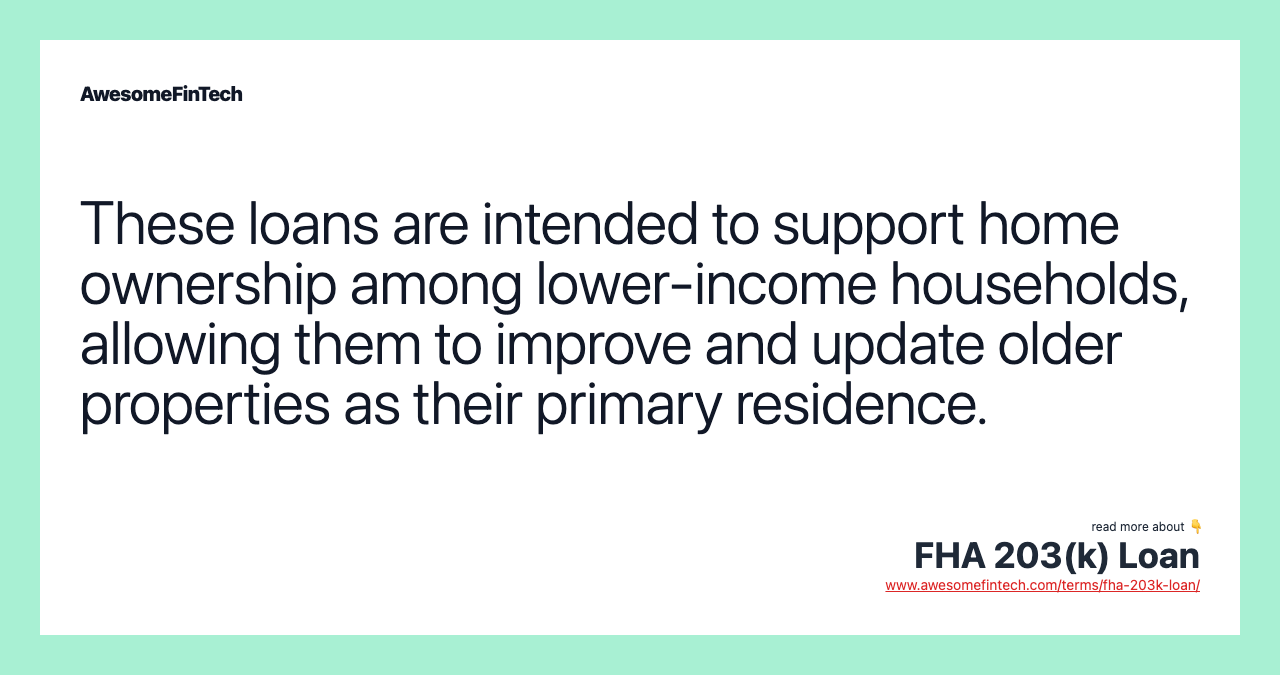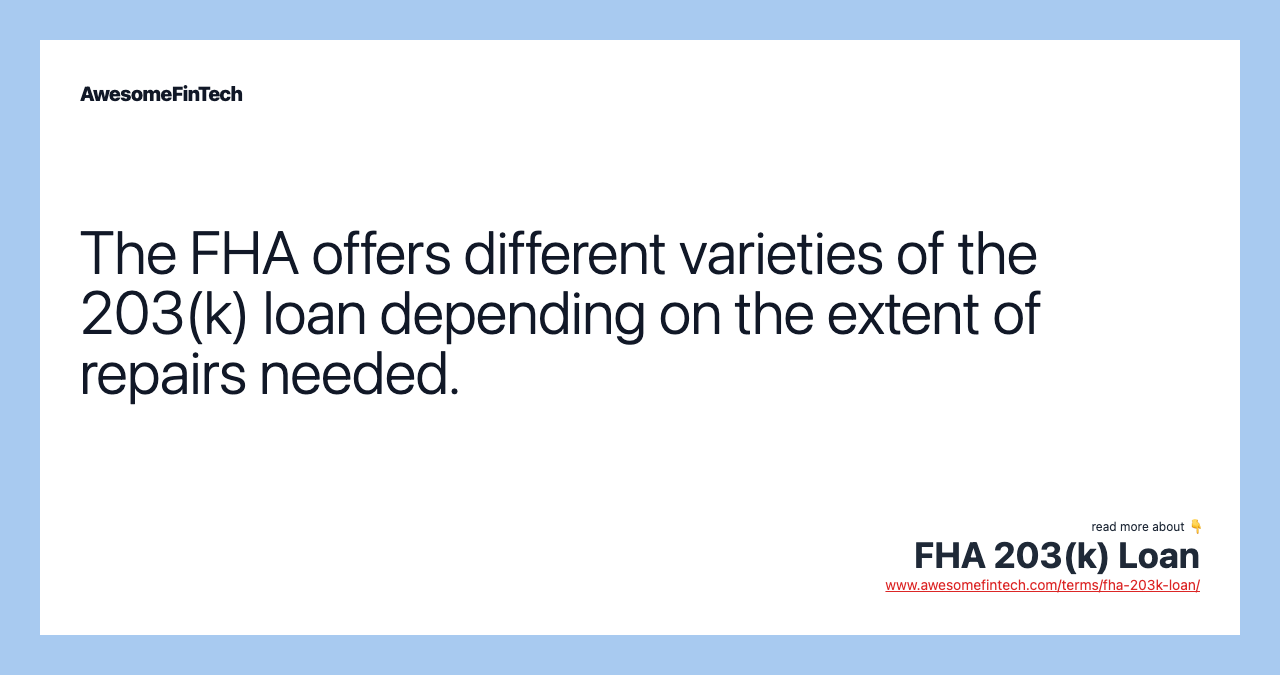FHA 203(k) Loan
An FHA 203(k) loan is a type of government-insured mortgage that allows the borrower to take out one loan for two purposes: home purchase and home renovation. The qualification requirements for an FHA 203(k) loan are similar to the requirements for a regular FHA loan, in terms of credit scoring, income, down payment requirements, and FHA loan limits. While an FHA 203(k) loan is a type of FHA construction loan, it's possible to get construction loans outside of the FHA program. An FHA 203(k) loan is a type of government-insured mortgage that allows the borrower to take out one loan for two purposes: home purchase and home renovation. An FHA 203(k) loan is a government-backed mortgage that is essentially a construction loan that finances both the purchase and repairs on a home.

What Is an FHA 203(k) Loan?
An FHA 203(k) loan is a type of government-insured mortgage that allows the borrower to take out one loan for two purposes: home purchase and home renovation. An FHA 203(k) loan is wrapped around rehabilitation or repairs to a home that will become the mortgagor’s primary residence. An FHA 203(k) is effectively an FHA construction loan.



Understanding FHA 203(k) Loans
The FHA 203(k) loan is meant to encourage families in low- to moderate-income brackets to purchase homes that are in dire need of repairs, especially homes that are situated in old communities. The program allows an individual to buy a home and renovate it under one fixed-rate or adjustable-rate mortgage. The amount that is borrowed includes the purchase price of the home and the cost of renovation, including materials and hired labor.
The loan may also cover temporary housing funding (if needed), which could be in the form of rent for the period that the house is under rehabilitation. The dual-purpose loan eliminates the need for a borrower to make two separate applications for a mortgage and a loan for home renovation, either of which may not be approved by the bank or may come at a higher combined cost.
Normally, lenders are unwilling to offer a mortgage for a property in need of major repairs due to their safety and livability standards. FHA 203(k) loans, which are government-backed, provide reassurance to lending institutions, as the cost of renovating the home is included in the mortgage package. The renovation fees are placed in an escrow account and disbursed as payment to the contractors as the work is completed. Complete renovation of the home should not take more than six months, as outlined in the FHA guide for a 203(k) loan.
Types of 203(k) Loans
There are two types of 203(k) loans: limited 203(k) and standard 203(k). The loans apply only to individuals and families who intend on making the property their primary residence. This means that real estate investors and house-flippers do not qualify. The work carried out must be contracted to a licensed handyman. If the mortgagor qualifies as one, they may act as their own general contractor and do the repair work themselves, using the money saved for cost overruns or additional improvements. They cannot, however, be reimbursed for their labor.
Limited 201(k): Minimal Repairs
A home that does not require much work would usually be paid for using the limited 203(k). This option does not include structural work on the home, such as adding new rooms or landscaping, and the home must be habitable throughout the renovation period. Repairs under the limited 203(k) are capped at $35,000.
Standard 2013(k): Extensive Work
The standard 203(k) includes any extensive repairs and structural work that need to be done in the home with no capped repair cost. The minimum amount that can be borrowed is $5,000.
Some of the repairs that an FHA 203(k) loan covers include plumbing, flooring, painting, heat and air-conditioning systems, bathroom and kitchen remodeling, improvement of health and safety standards, landscape improvements, implementing access tools for disabled persons, the addition of energy conservation systems, and window and door replacements. Renovations that are considered extravagant or luxurious — such as tennis courts, gazebos, and new swimming pools) — are not covered under an FHA 203(k) loan.
How Do Lenders Use an FHA 203(k) Loan?
The Federal Housing Administration (FHA) was created in 1934 during the period of the Great Depression, which saw a high rate of foreclosures and defaults. The FHA served to incentivize banks to give home loans to low- and medium-income earners, individuals with low credit scores, and first-time homebuyers with no credit history. This helped to stimulate the economy, as people who would normally not be approved for a loan were being issued mortgages. The FHA loan was created to insure these types of mortgages, so that in a case where the borrower defaults, the FHA would step in to cover the payments, thus minimizing the default risk faced by the lender.
High-income earners generally prefer to buy in newer and more-developed areas of a city. The FHA introduced the 203(k) loan specifically to encourage low-income earners who do not qualify for a standard mortgage to choose to live in run-down neighborhoods and upgrade them.
Getting an FHA 203(k) Loan
It is important to note that the FHA is not a lender; rather, it is a mortgage insurer. You get an FHA 203(k) loan by applying through your bank, credit union, or another lender. Not all lenders offer these loans. To find an approved lender, see HUD’s approved lender search.
The FHA also is not a home insurer or warranty provider. Homebuyers still need to purchase home insurance and warranties for their home and property.
Pros and Cons of FHA 203(k) Loans
As with other FHA loans, an individual can make a down payment of only 3.5%. As the loan is insured by the FHA, lenders may offer lower interest rates for a 203(k) loan compared to what borrowers may be quoted elsewhere. Interest rates will vary for each borrower depending on their credit history.
However, the FHA 203(k) loan is not without its costs. An up-front mortgage insurance premium has to be paid every month by the borrower. A supplemental origination fee may also be charged by the lending institution. In addition to the financial costs to the borrower, the rigorous paperwork required and the lengthy time it takes to hear back from the FHA and lender are factors to consider when applying for this program.
Overall, an individual with a low credit score seeking to own a home that may need to be fixed and modernized may realize that the FHA 203(k) has great benefits that outweigh its costs.
FHA 203(k) vs. Construction Loans
While an FHA 203(k) loan is a type of FHA construction loan, it's possible to get construction loans outside of the FHA program. A construction loan is typically a short-term loan that provides funding to cover the cost of building or rehabbing a home.
Construction loans may have higher interest rates than conventional mortgage loans. The money may be paid out in installments as construction gets underway and continues, rather than as a lump sum. The balance due on a construction loan may be paid in a lump sum at the end of the loan term. Alternately, homeowners may choose to convert a construction loan to a conventional mortgage.
If your lender doesn’t allow for automatic conversion of a construction loan to a conventional mortgage, you may need to apply for a brand-new loan to avoid having to make one large balloon payment.
FHA 203(k) Loan Qualifications
If you’re interested in an FHA 203(k) loan, it’s important to understand what you’ll need to qualify. The first step is finding an eligible lender if you haven’t done so already. Next, you’ll need to ensure that your purpose for getting the loan meets FHA 203(k) guidelines. Again, these types of loans can be used for:
If the property satisfies those guidelines, you can move forward with the application process. The qualification requirements for an FHA 203(k) loan are similar to the requirements for a regular FHA loan, in terms of credit scoring, income, down payment requirements, and FHA loan limits. That means you’ll need a credit score of at least 580 to make the purchase with a down payment of 3.5%. The typical score needed to get a standard mortgage is 620, though some lenders require a score as high as 740.
It’s possible to qualify for an FHA 203(k) loan with a credit score as low as 500, though that will require you to increase your down payment to 10%.
What Is an FHA 203(k) Loan?
An FHA 203(k) loan is designed to be used for home purchase and home renovation. There are two types: limited and standard. The amount borrowed accounts for both the purchase price of the home and renovation costs, which include materials and labor. It is intended to help rehabilitate run-down communities and aid lower-income people.
Does the FHA Make the Loan?
No. The FHA insures the loan. You must get the loan through a financial institution such as a bank or credit union.
Can You Use a 203(k) Loan for All Improvements?
No. Anything considered extravagant or luxurious — such as a tennis court, gazebo, or a new swimming pool — is not allowed. However, most repairs and upgrades do qualify, including rehabbing an existing swimming pool.
Related terms:
Adjustable-Rate Mortgage (ARM)
An adjustable-rate mortgage is a type of mortgage in which the interest rate paid on the outstanding balance varies according to a specific benchmark. read more
Balloon Payment
A balloon payment is an oversized payment due at the end of a mortgage. Terms are usually for just a short period of time before the payment comes due. read more
Construction Loan
A construction loan is a short-term loan used to finance the building or renovation of a home or real estate project. read more
Conventional Mortgage or Loan
A conventional mortgage is any type of home buyer’s loan not offered or secured by a government entity but instead is available through a private lender. read more
Credit History
Credit history refers to the ongoing documentation of an individual’s repayment of their debts. read more
Credit Score: , Factors, & Improving It
A credit score is a number between 300–850 that depicts a consumer's creditworthiness. The higher the score, the better a borrower looks to potential lenders. read more
Credit Union
A credit union is a member-owned financial cooperative that is created and operated by members and shares profits with owners. read more
Default
A default happens when a borrower fails to repay a portion or all of a debt, including interest or principal. read more
Escrow : Types, Examples, Pros & Cons
Escrow broadly refers to a third party that holds money or an asset on behalf of the other two parties in a transaction. read more
Federal Housing Administration (FHA)
The Federal Housing Administration (FHA) is a U.S. government agency that provides mortgage insurance to qualified, FHA-approved lenders. read more